Drive belt SUZUKI XL7 2007 2.G Owners Manual
[x] Cancel search | Manufacturer: SUZUKI, Model Year: 2007, Model line: XL7, Model: SUZUKI XL7 2007 2.GPages: 274, PDF Size: 6.12 MB
Page 15 of 274

1-3 SEATS AND RESTRAINT SYSTEMS
78J00-03E
Driver’s seat with manual recline and
manual height adjuster shown
1618868
To adjust the seatback on the driver’s seat,
lift the lever on the rear outboard side of
the seat and move the seatback to the
desired position. Then release the lever to
lock the seatback in place.Passenger seat with folding seatback
option shown
1618866
To adjust the seatback on the front passen-
ger’s seat, lift the lever on the outboard
side of the seat and move the seatback to
the desired position. Then release the
lever to lock the seatback in place. If your
front passenger’s seat is a flat folding seat,
you must fully raise the lever to disengage
the seatback.
806881
WARNING
Sitting in a reclined position when
your vehicle is in motion can be dan-
gerous. Even if you buckle up, your
safety belts cannot do their job when
you are reclined like this.
The shoulder belt cannot do its job
because it will not be against your
body. Instead, it will be in front of
you. In a crash, you could go into it,
receiving neck or other injuries.
The lap belt cannot do its job either.
In a crash, the belt could go up over
your abdomen. The belt forces would
be there, not at your pelvic bones.
This could cause serious internal
injuries.
(Continued)
Page 23 of 274
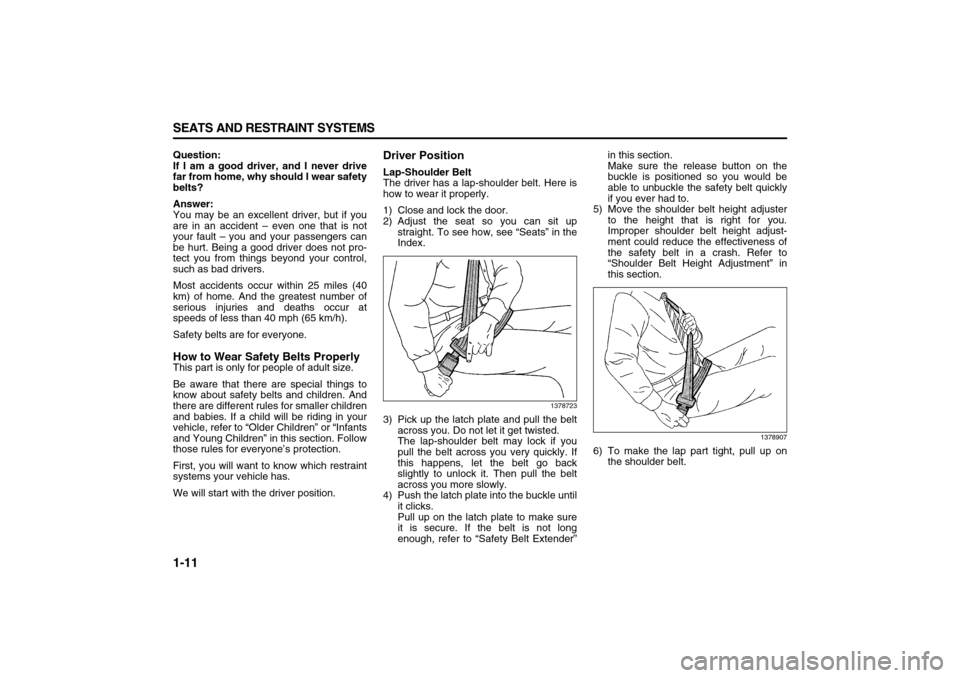
1-11 SEATS AND RESTRAINT SYSTEMS
78J00-03E
Question:
If I am a good driver, and I never drive
far from home, why should I wear safety
belts?
Answer:
You may be an excellent driver, but if you
are in an accident – even one that is not
your fault – you and your passengers can
be hurt. Being a good driver does not pro-
tect you from things beyond your control,
such as bad drivers.
Most accidents occur within 25 miles (40
km) of home. And the greatest number of
serious injuries and deaths occur at
speeds of less than 40 mph (65 km/h).
Safety belts are for everyone.How to Wear Safety Belts ProperlyThis part is only for people of adult size.
Be aware that there are special things to
know about safety belts and children. And
there are different rules for smaller children
and babies. If a child will be riding in your
vehicle, refer to “Older Children” or “Infants
and Young Children” in this section. Follow
those rules for everyone’s protection.
First, you will want to know which restraint
systems your vehicle has.
We will start with the driver position.
Driver PositionLap-Shoulder Belt
The driver has a lap-shoulder belt. Here is
how to wear it properly.
1) Close and lock the door.
2) Adjust the seat so you can sit up
straight. To see how, see “Seats” in the
Index.
1378723
3) Pick up the latch plate and pull the belt
across you. Do not let it get twisted.
The lap-shoulder belt may lock if you
pull the belt across you very quickly. If
this happens, let the belt go back
slightly to unlock it. Then pull the belt
across you more slowly.
4) Push the latch plate into the buckle until
it clicks.
Pull up on the latch plate to make sure
it is secure. If the belt is not long
enough, refer to “Safety Belt Extender”in this section.
Make sure the release button on the
buckle is positioned so you would be
able to unbuckle the safety belt quickly
if you ever had to.
5) Move the shoulder belt height adjuster
to the height that is right for you.
Improper shoulder belt height adjust-
ment could reduce the effectiveness of
the safety belt in a crash. Refer to
“Shoulder Belt Height Adjustment” in
this section.
1378907
6) To make the lap part tight, pull up on
the shoulder belt.
Page 26 of 274
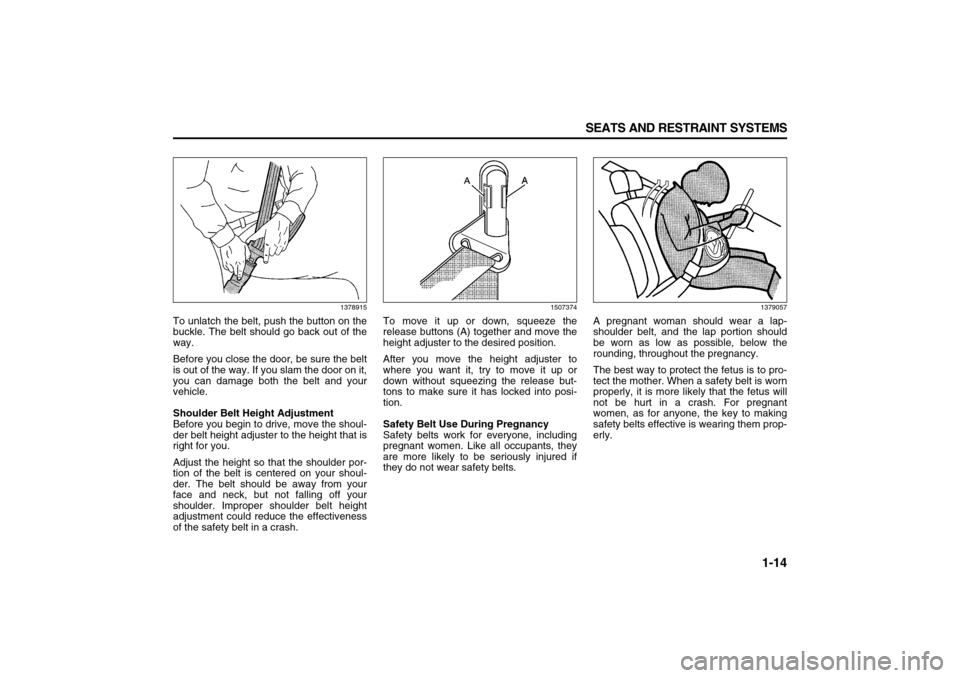
1-14 SEATS AND RESTRAINT SYSTEMS
78J00-03E
1378915
To unlatch the belt, push the button on the
buckle. The belt should go back out of the
way.
Before you close the door, be sure the belt
is out of the way. If you slam the door on it,
you can damage both the belt and your
vehicle.
Shoulder Belt Height Adjustment
Before you begin to drive, move the shoul-
der belt height adjuster to the height that is
right for you.
Adjust the height so that the shoulder por-
tion of the belt is centered on your shoul-
der. The belt should be away from your
face and neck, but not falling off your
shoulder. Improper shoulder belt height
adjustment could reduce the effectiveness
of the safety belt in a crash.
1507374
To move it up or down, squeeze the
release buttons (A) together and move the
height adjuster to the desired position.
After you move the height adjuster to
where you want it, try to move it up or
down without squeezing the release but-
tons to make sure it has locked into posi-
tion.
Safety Belt Use During Pregnancy
Safety belts work for everyone, including
pregnant women. Like all occupants, they
are more likely to be seriously injured if
they do not wear safety belts.
1379057
A pregnant woman should wear a lap-
shoulder belt, and the lap portion should
be worn as low as possible, below the
rounding, throughout the pregnancy.
The best way to protect the fetus is to pro-
tect the mother. When a safety belt is worn
properly, it is more likely that the fetus will
not be hurt in a crash. For pregnant
women, as for anyone, the key to making
safety belts effective is wearing them prop-
erly.
Page 27 of 274
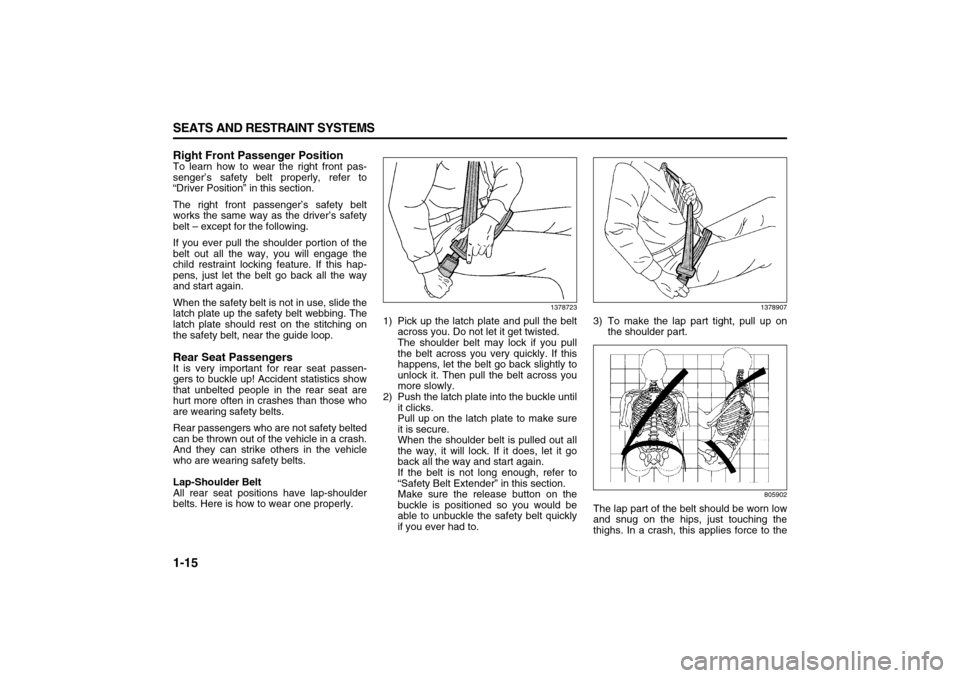
1-15 SEATS AND RESTRAINT SYSTEMS
78J00-03E
Right Front Passenger PositionTo learn how to wear the right front pas-
senger’s safety belt properly, refer to
“Driver Position” in this section.
The right front passenger’s safety belt
works the same way as the driver’s safety
belt – except for the following.
If you ever pull the shoulder portion of the
belt out all the way, you will engage the
child restraint locking feature. If this hap-
pens, just let the belt go back all the way
and start again.
When the safety belt is not in use, slide the
latch plate up the safety belt webbing. The
latch plate should rest on the stitching on
the safety belt, near the guide loop.Rear Seat PassengersIt is very important for rear seat passen-
gers to buckle up! Accident statistics show
that unbelted people in the rear seat are
hurt more often in crashes than those who
are wearing safety belts.
Rear passengers who are not safety belted
can be thrown out of the vehicle in a crash.
And they can strike others in the vehicle
who are wearing safety belts.
Lap-Shoulder Belt
All rear seat positions have lap-shoulder
belts. Here is how to wear one properly.
1378723
1) Pick up the latch plate and pull the belt
across you. Do not let it get twisted.
The shoulder belt may lock if you pull
the belt across you very quickly. If this
happens, let the belt go back slightly to
unlock it. Then pull the belt across you
more slowly.
2) Push the latch plate into the buckle until
it clicks.
Pull up on the latch plate to make sure
it is secure.
When the shoulder belt is pulled out all
the way, it will lock. If it does, let it go
back all the way and start again.
If the belt is not long enough, refer to
“Safety Belt Extender” in this section.
Make sure the release button on the
buckle is positioned so you would be
able to unbuckle the safety belt quickly
if you ever had to.
1378907
3) To make the lap part tight, pull up on
the shoulder part.
805902
The lap part of the belt should be worn low
and snug on the hips, just touching the
thighs. In a crash, this applies force to the
Page 30 of 274
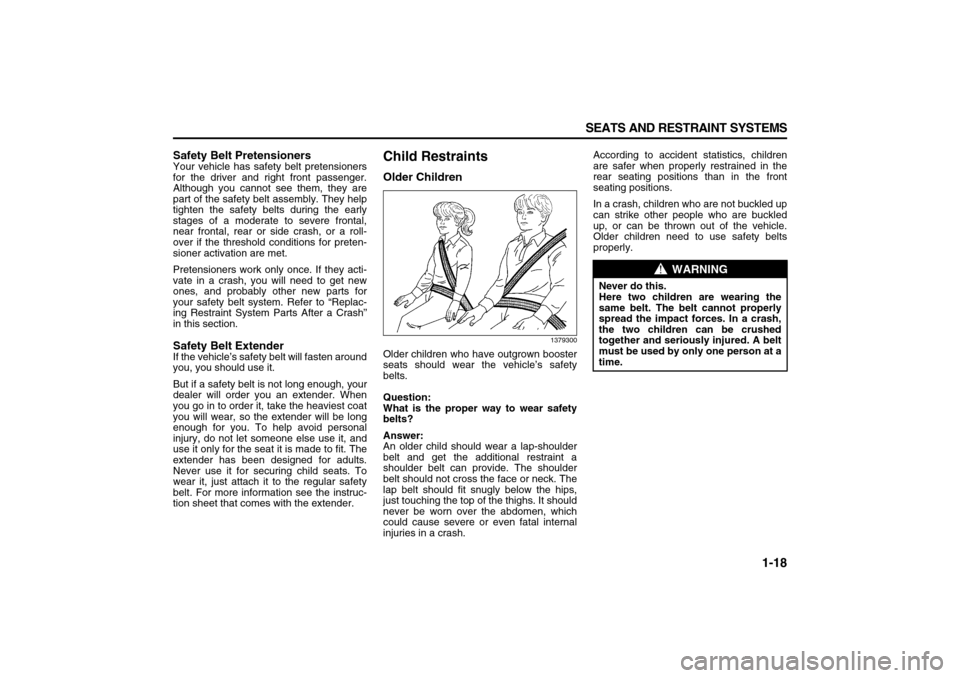
1-18 SEATS AND RESTRAINT SYSTEMS
78J00-03E
Safety Belt PretensionersYour vehicle has safety belt pretensioners
for the driver and right front passenger.
Although you cannot see them, they are
part of the safety belt assembly. They help
tighten the safety belts during the early
stages of a moderate to severe frontal,
near frontal, rear or side crash, or a roll-
over if the threshold conditions for preten-
sioner activation are met.
Pretensioners work only once. If they acti-
vate in a crash, you will need to get new
ones, and probably other new parts for
your safety belt system. Refer to “Replac-
ing Restraint System Parts After a Crash”
in this section.Safety Belt ExtenderIf the vehicle’s safety belt will fasten around
you, you should use it.
But if a safety belt is not long enough, your
dealer will order you an extender. When
you go in to order it, take the heaviest coat
you will wear, so the extender will be long
enough for you. To help avoid personal
injury, do not let someone else use it, and
use it only for the seat it is made to fit. The
extender has been designed for adults.
Never use it for securing child seats. To
wear it, just attach it to the regular safety
belt. For more information see the instruc-
tion sheet that comes with the extender.
Child RestraintsOlder Children
1379300
Older children who have outgrown booster
seats should wear the vehicle’s safety
belts.
Question:
What is the proper way to wear safety
belts?
Answer:
An older child should wear a lap-shoulder
belt and get the additional restraint a
shoulder belt can provide. The shoulder
belt should not cross the face or neck. The
lap belt should fit snugly below the hips,
just touching the top of the thighs. It should
never be worn over the abdomen, which
could cause severe or even fatal internal
injuries in a crash.According to accident statistics, children
are safer when properly restrained in the
rear seating positions than in the front
seating positions.
In a crash, children who are not buckled up
can strike other people who are buckled
up, or can be thrown out of the vehicle.
Older children need to use safety belts
properly.
WARNING
Never do this.
Here two children are wearing the
same belt. The belt cannot properly
spread the impact forces. In a crash,
the two children can be crushed
together and seriously injured. A belt
must be used by only one person at a
time.
Page 40 of 274

1-28 SEATS AND RESTRAINT SYSTEMS
78J00-03E
to Put the Restraint” in this section for
additional information.Securing a Child Restraint
Designed for the LATCH System
1252139
A. Passenger’s side rear seat lower
anchors
B. Center rear seat lower anchors
C. Driver’s side rear seat lower anchors
Make sure to attach the child restraint at
the proper anchor location.
This system is designed to make installa-
tion of child restraints easier. When using
lower anchors, do not use the vehicle’s
safety belts. Instead use the vehicle’s
anchors and child restraint attachments to
secure the restraints. Some restraints also
use another vehicle anchor to secure a top
tether.
1) Attach and tighten the lower attach-
ments to the lower anchors. If the child
restraint does not have lower attach-
ments or the desired seating position
does not have lower anchors, secure
WARNING
If a LATCH-type child restraint is not
attached to anchors, the restraint will
not be able to protect the child cor-
rectly. In a crash, the child could be
seriously injured or killed. Make sure
that a LATCH-type child restraint is
properly installed using the anchors,
or use the vehicle’s safety belts to
secure the restraint, following the
instructions that came with that
restraint, and also the instructions in
this manual.
WARNING
Each top tether anchor and lower
anchor in the vehicle is designed to
hold only one child restraint. Attach-
ing more than one child restraint to a
single anchor could cause the anchor
or attachment to come loose or even
break during a crash. A child or oth-
ers could be injured if this happens.
To help prevent injury to people and
damage to your vehicle, attach only
one child restraint per anchor.
WARNING
Children can be seriously injured or
strangled if a shoulder belt is
wrapped around their neck and the
safety belt continues to tighten.
Secure any unused safety belts
behind the child restraint so children
cannot reach them. Pull the shoulder
belt all the way out of the retractor to
set the lock, if your vehicle has one,
after the child restraint has been
installed. Be sure to follow the
instructions of the child restraint
manufacturer.
CAUTION
Contact between the child restraint or
the LATCH attachment parts and the
vehicle’s safety belt assembly may
cause damage to these parts. Make
sure when securing unused safety
belts behind the child restraint that
there is no contact between the child
restraint or the LATCH attachment
parts and the vehicle’s safety belt
assembly.
Folding an empty rear seat with the
safety belts secured may cause dam-
age to the safety belt or the seat.
When removing the child restraint,
always remember to return the safety
belts to their normal, stowed position
before folding the rear seat.
Page 45 of 274

1-33 SEATS AND RESTRAINT SYSTEMS
78J00-03E
the belt, and feed the shoulder belt
back into the retractor. If you are using
a forward-facing child restraint, you
may find it helpful to use your knee to
push down on the child restraint as you
tighten the belt. You should not be able
to pull more of the belt from the retrac-
tor once the lock has been set.
7) Push and pull the child restraint in dif-
ferent directions to be sure it is secure.
8) If the airbag is off, the off indicator on
the instrument panel will be lit and stay
lit when the key is turned to RUN or
START.
If a child restraint has been installed and
the on indicator is lit, turn the vehicle off.
Remove the child restraint from the vehicle
and reinstall the child restraint.
If, after reinstalling the child restraint and
restarting the vehicle, the on indicator is
still lit, check to make sure that the vehi-
cle’s seatback is not pressing the child
restraint into the seat cushion. If this hap-
pens, slightly recline the vehicle’s seatback
and adjust the seat cushion if possible.
Also make sure the child restraint is not
trapped under the vehicle head restraint. If
this happens, adjust the head restraint.
If the on indicator is still lit, secure the child
in the child restraint in a rear seat position
in the vehicle if one is available and check
with your dealer.To remove the child restraint, if the top
tether is attached to the top tether anchor,
disconnect it. Unbuckle the vehicle’s safety
belt and let it go back all the way. The
safety belt will move freely again and be
ready to work for an adult or larger child
passenger.
Airbag SystemYour vehicle has a frontal airbag for the
driver and a frontal airbag for the right front
passenger. Your vehicle also has roof-
mounted rollover airbags designed for
either side impact or rollover deployment.
Roof-mounted rollover airbags are avail-
able for the driver and the passenger
seated directly behind the driver and for
the right front passenger and the passen-
ger seated directly behind that passenger.
For roof-mounted rollover airbags, the
word AIRBAG will appear along the head-
liner or trim.
Also, if your vehicle has a third row pas-
senger seat, your vehicle will have third
row roof-mounted rollover airbags.
Airbags are designed to supplement the
protection provided by safety belts. Even
though today’s airbags are also designed
to help reduce the risk of injury from the
force of an inflating bag, all airbags must
inflate very quickly to do their job.
Here are the most important things to
know about the airbag system:
Page 46 of 274

1-34 SEATS AND RESTRAINT SYSTEMS
78J00-03E
WARNING
You can be severely injured or killed
in a crash if you are not wearing your
safety belt – even if you have airbags.
Wearing your safety belt during a
crash helps reduce your chance of
hitting things inside the vehicle or
being ejected from it. Airbags are
“supplemental restraints” to the
safety belts. All airbags are designed
to work with safety belts but do not
replace them.
Frontal airbags for the driver and
right front passenger are designed to
deploy in moderate to severe frontal
and near frontal crashes. They are
not designed to inflate in rollover,
rear crashes, or in many side
crashes. And, for some unrestrained
occupants, frontal airbags may pro-
vide less protection in frontal
crashes than more forceful airbags
have provided in the past.
(Continued)
WARNING
(Continued)
Roof-mounted rollover airbags are
designed to inflate in moderate to
severe crashes where something hits
the side of your vehicle, during a
vehicle rollover, or in a severe frontal
impact. They are not designed to
inflate in rear crashes. If your vehicle
has roof-mounted airbags, they are
designed to provide both side impact
protection and rollover protection.
Everyone in your vehicle should wear
a safety belt properly – whether or
not there is an airbag for that person.
WARNING
Both frontal and roof-mounted roll-
over airbags inflate with great force,
faster than the blink of an eye. If you
are too close to an inflating airbag, as
you would be if you were leaning for-
ward, it could seriously injure you.
Safety belts help keep you in position
for airbag inflation before and during
a crash. Always wear your safety belt
even with frontal airbags. The driver
should sit as far back as possible
while still maintaining control of the
vehicle. Occupants should not lean
on or sleep against the door in the
first or second row seats, or the rear
windows in the third row seat, if your
vehicle has roof-mounted rollover air-
bags.
Page 47 of 274
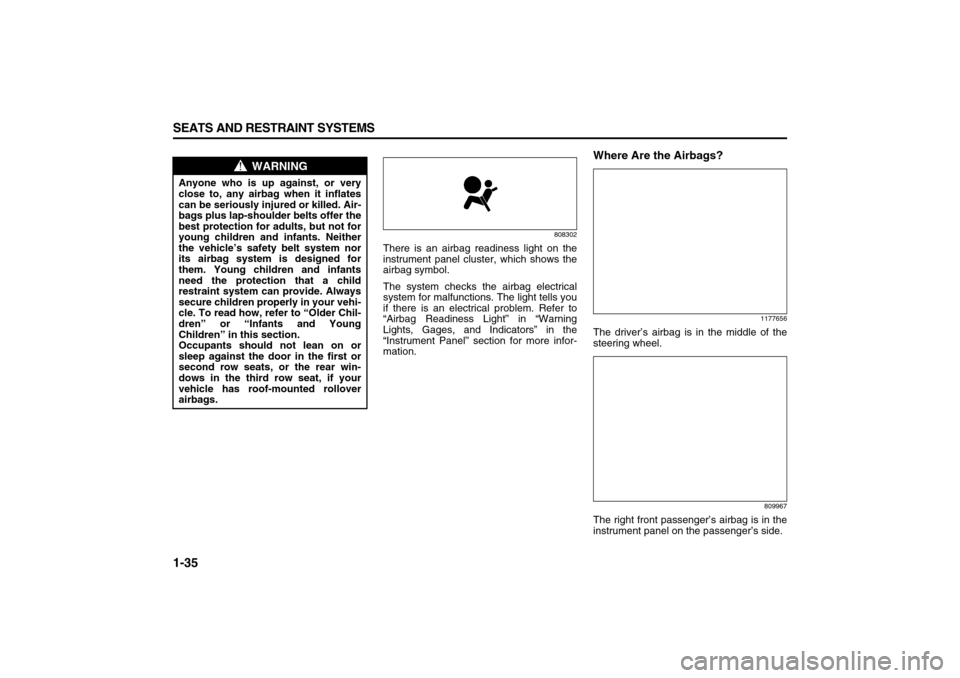
1-35 SEATS AND RESTRAINT SYSTEMS
78J00-03E
808302
There is an airbag readiness light on the
instrument panel cluster, which shows the
airbag symbol.
The system checks the airbag electrical
system for malfunctions. The light tells you
if there is an electrical problem. Refer to
“Airbag Readiness Light” in “Warning
Lights, Gages, and Indicators” in the
“Instrument Panel” section for more infor-
mation.
Where Are the Airbags?
1177656
The driver’s airbag is in the middle of the
steering wheel.
809967
The right front passenger’s airbag is in the
instrument panel on the passenger’s side.
WARNING
Anyone who is up against, or very
close to, any airbag when it inflates
can be seriously injured or killed. Air-
bags plus lap-shoulder belts offer the
best protection for adults, but not for
young children and infants. Neither
the vehicle’s safety belt system nor
its airbag system is designed for
them. Young children and infants
need the protection that a child
restraint system can provide. Always
secure children properly in your vehi-
cle. To read how, refer to “Older Chil-
dren” or “Infants and Young
Children” in this section.
Occupants should not lean on or
sleep against the door in the first or
second row seats, or the rear win-
dows in the third row seat, if your
vehicle has roof-mounted rollover
airbags.
Page 50 of 274
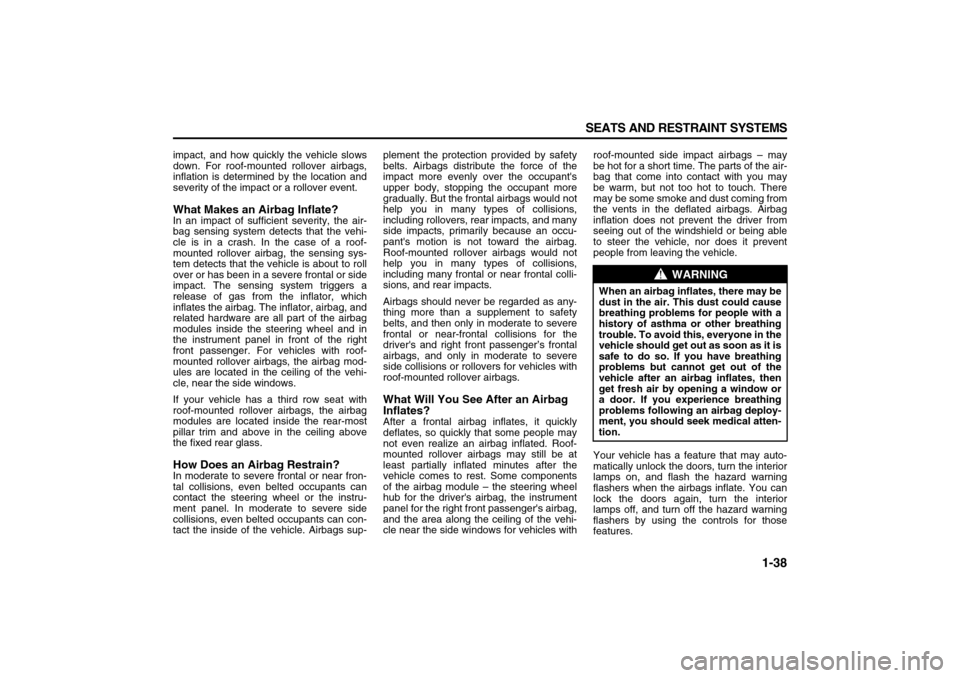
1-38 SEATS AND RESTRAINT SYSTEMS
78J00-03E
impact, and how quickly the vehicle slows
down. For roof-mounted rollover airbags,
inflation is determined by the location and
severity of the impact or a rollover event.What Makes an Airbag Inflate?In an impact of sufficient severity, the air-
bag sensing system detects that the vehi-
cle is in a crash. In the case of a roof-
mounted rollover airbag, the sensing sys-
tem detects that the vehicle is about to roll
over or has been in a severe frontal or side
impact. The sensing system triggers a
release of gas from the inflator, which
inflates the airbag. The inflator, airbag, and
related hardware are all part of the airbag
modules inside the steering wheel and in
the instrument panel in front of the right
front passenger. For vehicles with roof-
mounted rollover airbags, the airbag mod-
ules are located in the ceiling of the vehi-
cle, near the side windows.
If your vehicle has a third row seat with
roof-mounted rollover airbags, the airbag
modules are located inside the rear-most
pillar trim and above in the ceiling above
the fixed rear glass.How Does an Airbag Restrain?In moderate to severe frontal or near fron-
tal collisions, even belted occupants can
contact the steering wheel or the instru-
ment panel. In moderate to severe side
collisions, even belted occupants can con-
tact the inside of the vehicle. Airbags sup-plement the protection provided by safety
belts. Airbags distribute the force of the
impact more evenly over the occupant's
upper body, stopping the occupant more
gradually. But the frontal airbags would not
help you in many types of collisions,
including rollovers, rear impacts, and many
side impacts, primarily because an occu-
pant's motion is not toward the airbag.
Roof-mounted rollover airbags would not
help you in many types of collisions,
including many frontal or near frontal colli-
sions, and rear impacts.
Airbags should never be regarded as any-
thing more than a supplement to safety
belts, and then only in moderate to severe
frontal or near-frontal collisions for the
driver's and right front passenger’s frontal
airbags, and only in moderate to severe
side collisions or rollovers for vehicles with
roof-mounted rollover airbags.
What Will You See After an Airbag
Inflates?After a frontal airbag inflates, it quickly
deflates, so quickly that some people may
not even realize an airbag inflated. Roof-
mounted rollover airbags may still be at
least partially inflated minutes after the
vehicle comes to rest. Some components
of the airbag module – the steering wheel
hub for the driver's airbag, the instrument
panel for the right front passenger's airbag,
and the area along the ceiling of the vehi-
cle near the side windows for vehicles withroof-mounted side impact airbags – may
be hot for a short time. The parts of the air-
bag that come into contact with you may
be warm, but not too hot to touch. There
may be some smoke and dust coming from
the vents in the deflated airbags. Airbag
inflation does not prevent the driver from
seeing out of the windshield or being able
to steer the vehicle, nor does it prevent
people from leaving the vehicle.
Your vehicle has a feature that may auto-
matically unlock the doors, turn the interior
lamps on, and flash the hazard warning
flashers when the airbags inflate. You can
lock the doors again, turn the interior
lamps off, and turn off the hazard warning
flashers by using the controls for those
features.
WARNING
When an airbag inflates, there may be
dust in the air. This dust could cause
breathing problems for people with a
history of asthma or other breathing
trouble. To avoid this, everyone in the
vehicle should get out as soon as it is
safe to do so. If you have breathing
problems but cannot get out of the
vehicle after an airbag inflates, then
get fresh air by opening a window or
a door. If you experience breathing
problems following an airbag deploy-
ment, you should seek medical atten-
tion.